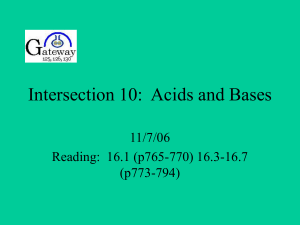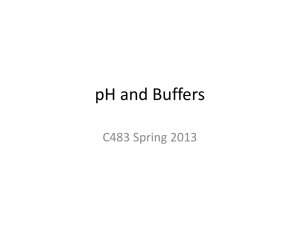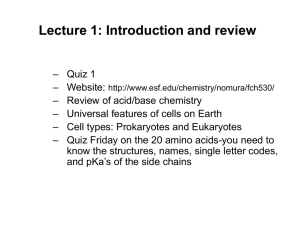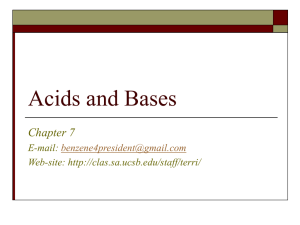Chapter 14 Lecture
advertisement
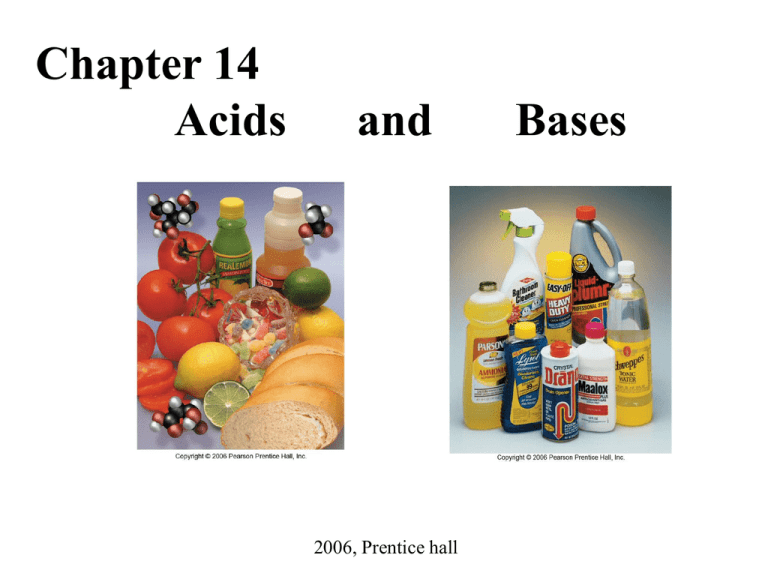
Chapter 14 Acids and 2006, Prentice hall Bases CHAPTER OUTLINE General Properties Arrhenius Acids & Bases Strength of Acids & Bases Brønsted-Lowery Acids & Bases Ionization of Water pH and pOH Scales 2 GENRAL PROPERTIES OF ACIDS & BASES Many common substances in our daily lives are acids and bases. Oranges, lemons and vinegar are examples of acids. In addition, our stomachs contain acids that help digest foods. Antacid tablets taken for heartburn and ammonia cleaning solutions are examples of bases. 3 GENRAL PROPERTIES OF ACIDS General properties associated with acids include the following: sour taste change color of litmus from blue to red react with metals to produce H2 gas react with bases to produce salt & water 4 Structure of Acids • binary acids have acid hydrogens attached to a nonmetal atom – HCl, HF Hydrofluoric acid Structure of Acids • oxy acids have acid hydrogens attached to an oxygen atom – H2SO4, HNO3 Structure of Acids • carboxylic acids have COOH group – HC2H3O2, H3C6H5O3 • only the first H in the formula is acidic – the H is on the COOH GENRAL PROPERTIES OF BASES General properties associated with bases include the following: bitter taste slippery, soapy feeling change color of litmus from red to blue react with acids to produce salt & water 8 Structure of Bases • most ionic bases contain OH ions – NaOH, Ca(OH)2 • some contain CO32ions – CaCO3 NaHCO3 • molecular bases contain structures that react with H+ – mostly amine groups amine groups Ammonia H–N–H H + H+ H H – N+ – H H Ammonium ion ARRHENIUS ACIDS & BASES According The most to the common Arrhenius definition definition, of acids and bases was formulated by the Swedish chemist Svante Acids are substances that produce hydronium Arrhenius ions (H3O+)inin1884. aqueous solution. HCl (g) + H2O (l) H3O+ (aq) + Cl– (aq) Commonly written as HCl (g) H2O H+ (aq) + Cl– (aq) 11 ARRHENIUS ACIDS & BASES According to the Arrhenius definition, Bases are substances that produce hydroxide ion (OH-) in aqueous solution. NaOH (s) H2O NH3 (aq) + H2O (l) Na+ (aq) + OH– (aq) NH4+ (aq) + OH – (aq) 12 BRØNSTED-LOWRY ACIDS & BASES The According Arrhenius to Brønsted-Lowry definition of acids definition, and bases anis limited acid is atoproton aqueous donor, solutions. and a base is a proton A substance that can act as a Brønsted-Lowry acid acceptor. base A broader definition acids amphiprotic. and bases was and (such as water) isofcalled developed by Brønsted and Lowry in the early 20th century. Base Acid Acid Base ++ (aq) + OH – –(aq) NH HCl (aq) (g) + H O (l) → NH H O Cl (aq) 3 2 3 4 13 BRØNSTED-LOWRY ACIDS & BASES In Brønsted-Lowry definition, any pair of molecules or ions that can be inter-converted by transfer of a proton is called conjugate acid-base pair. HCl (g) + H2O (l) → H3O+ (aq) + Cl– (aq) Acid Base Conjugate acid Conjugate base 14 BRØNSTED-LOWRY ACIDS & BASES NH3 (aq) + H2O (l) → NH4+ (aq) + OH– (aq) Base Acid Conjugate acid Conjugate base 15 Example 1: Identify the conjugate acid-base pairs for each reaction shown below: H2O + Acid Cl Base HCl + Conjugate acid OH Conjugate base 16 Example 1: Identify the conjugate acid-base pairs for each reaction shown below: C6H5OH + C2H5O C6H5O + C2H5OH Acid Base Conjugate base Conjugate acid 17 Example 2: Write the formula for the conjugate acid for each base shown: HS + H+ H2S NH3 + H+ NH4+ CO32 + H+ HCO3 18 Example 3: Write the formula for the conjugate base for each acid shown: HI - H+ I CH3OH - H+ CH3O HNO3 - H+ NO3 19 ACID & BASE STRENGTH According Strong acids to and the Arrhenius bases are those definition, that ionize the strength completely of acids in water. and bases is based on the of their water.electrolytes. amount Strong acids andionization bases arein strong H 2O ++ - NaO H (aq) (s) ¾ ¾¾ ¾ ¾ Na (aq) (aq)++Cl O H(aq) (aq) H Cl ® H 100 100 100 1M 1M 1M 20 ACID & BASE STRENGTH Weak acids and bases are those that ionize partially in water. Weak acids and bases are weak electrolytes. H O + 2 + ¾ ¾ ® H C H O H (aq) + H 3+OO2 H(aq)(aq) ¾ ® ¬2 O ¾ (l) ¾ ¾ ¬ ¾¾ NH 4 C NH 3 (aq) (aq) 2 3 +2 H 2 100 ~1 ~1 1M ~0.01M ~0.01M 21 IONIZATION OF STRONG vs. WEAK ACIDS Ionizes completely Ionizes partially 22 COMMON ACIDS Strong Acids Weak Acids HCl Hydrochloric acid HC2H3O2 Acetic acid HBr Hydrobromic acid H2CO3 Carbonic acid HI Hydroiodic acid H3PO4 Phosphoric acid HNO3 Nitric acid HF Hydrofluoric acid H2SO4 Sulfuric acid HCN Hydrocyanic acid H2S Hydrosulfuric acid 23 COMMON BASES Strong Bases Weak Bases LiOH Lithium hydroxide NH3 Ammonia NaOH Sodium hydroxide CO(NH2)2 Urea Ca(OH)2 Calcium hydroxide KOH Potassium hydroxide Ba(OH)2 Barium hydroxide 24 COMPARISON OF ACIDS & BASES 25 Titration • using reaction stoichiometry to determine the concentration of an unknown solution • Titrant (unknown solution) added from a buret • indicators are chemicals added to help determine when a reaction is complete • the endpoint of the titration occurs when the reaction is complete Titration Titration The base solution is the titrant in the buret. As the base is added to the acid, the H+ reacts with the OH– to form water. But there is still excess acid present so the color does not change. At the titration’s endpoint, just enough base has been added to neutralize all the acid. At this point the indicator changes color. Example 1 •The titration of 10.00 mL HCl solution of unknown concentration requires 12.54 mL of 0.100 M NaOH solution to reach the end point. What is the concentration of the unknown HCl solution? Find: concentration HCl, M Collect Needed Equations and Conversion Factors: HCl(aq) + NaOH(aq) → NaCl(aq) + H2O(l) 1 mole HCl = 1 mole NaOH 0.100 M NaOH 0.100 mol NaOH 1 L sol’n Molarity moles solute liters solution 12.54 mL NaOH 0.001 L 0.100 mol NaOH 1 mL 1L 1 mol HCl 1 mole NaOH = 1.25 x 10-3 mol HCl 10.00 mL HCl 0.001 L 0.01000 L HCl 1 mL Molarity 1.25 x 10 -3 moles HCl 0.125 M 0.01000 L HCl molarity = 0.125 M HCl IONIZATION OF WATER Water can act both as an acid and a base. In pure water, one water molecule donates a proton to another water molecule to produce ions. H2O Acid + H2O Base H3O+ Conjugate acid + OH– Conjugate base 31 IONIZATION OF WATER + + andOH When Allpure In aqueous the water, concentrations solutions the transfer haveofof HH3protons O between OH– –ions. are 3O and water molecules together, produces the ion-product equal numbers constant multiplied An increase in the concentration of one of of the +isand – ions. H (K O ) formed. OH ions 3w will cause an equilibrium shift that causes a The decrease number in of theions other produced one. in pure water is very small, as indicated below: [H3O+] = [OH–] = 1.0 x 10-7 M Kw=[H3O+][OH–] =[1.0x10-7][1.0x10-7]=1.0x10-14 32 ACIDIC & BASIC SOLUTIONS When [H3O+] is and greater [OH–]than are equal [OH–]ininaa solution, it is acidic. neutral. For example, if [H3O+] is 1.0 x 10–4 M, then [OH–] would be 1.0 x 10–10 M. [O H ]= Kw + [H 3 O ] = 1.0 x 10 14 1.0 x 10 4 =1.0 x 10 10 M 33 ACIDIC & BASIC SOLUTIONS When [OH-] is greater than [H3O+] in a solution, it is basic. For example, if [OH-] is 1.0 x 10–6 M, then [H3O+] would be 1.0 x 10–8 M. + [H 3 O ]= Kw [O H ] = 1.0 x 10 -14 1.0 x 10 -6 =1.0 x 10 -8 M 34 ACIDIC & BASIC SOLUTIONS Basic Acidic Neutral [H3O+]>[OH-] [H3O+]=[OH-] [H3O+]<[OH-] 35 pH SCALE The acidity of a solution is commonly measured on a pH scale. The pH scale ranges from 0-14, where acidic solutions are less than 7 and basic solutions are greater than 7. pH = -log [H3O+] 36 pH SCALE Acidic solutions pH < 7 H3O+ > 1x10-7 Neutral solutions pH = 7 H3O+ = 1x10-7 Basic solutions pH > 7 H3O+ < 1x10-7 37 Example 1: The [H3O+] of a liquid detergent is 1.4x10–9 M. Calculate its pH. Solution is basic pH = -log [H3O+] = -log [1.4x10-9] = -(-8.85) pH = 8.85 2 significant figures The number of decimal places in a logarithm is equal to the number of significant figures in the measurement. 38 Example 2: The pH of black coffee is 5.3. Calculate its Solution [H3O+]. is acidic [H3O+] = antilog (-pH) = 10 –pH = 10 -5.3 [H3O+] = 5 x 10-6 1 significant figure 39 Example 3: The [H3O+] of a solution is 3.5 x 10–3 M. Calculate its pH. Solution is acidic pH = -log [H3O+] = -log [3.5x10-3] = -(-2.46) pH = 2.46 2 significant figures 40 Example 4: The pH of tomato juice is 4.1. Calculate its [H3O+].Solution is acidic [H3O+] = antilog (-pH) = 10 –pH = 10 -4.1 [H3O+] = 8 x 10-5 1 significant figure 41 Example 5: The [OH] of a cleaning solution is 1.0 x 105 M. What is the pH of this solution? 2 sig figs Kw=[H3O+][OH–Solution ] is basic [H3O+] = Kw [O H ] pH = log[H3O+] = 1.0 x 10 14 1.0 x 10 5 = 1.0 x 109 M = log(1.0x109) = 9.00 42 Example 6: The pH of a solution is 11.50. Calculate the [H3O+] Solution for this solution. is basic [H3O+] = antilog (-pH) = 10 –pH = 10 -11.50 [H3O+] = 3.2 x 10-12 43 THE END 44

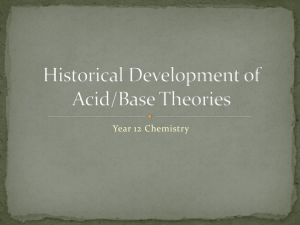
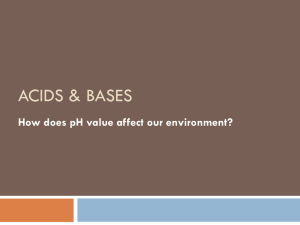
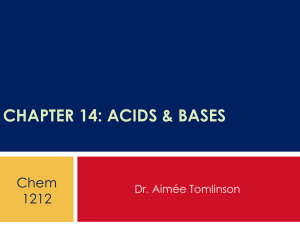
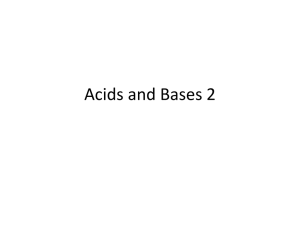
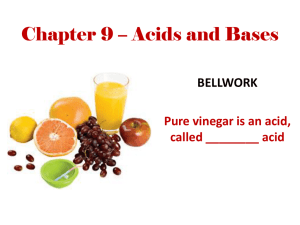
![pH = - log [H + ]](http://s2.studylib.net/store/data/005622524_1-002df1ea50d2a849b15deb604928664e-300x300.png)
